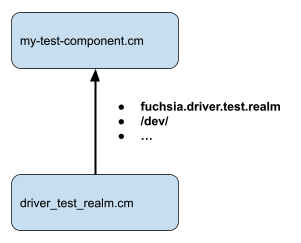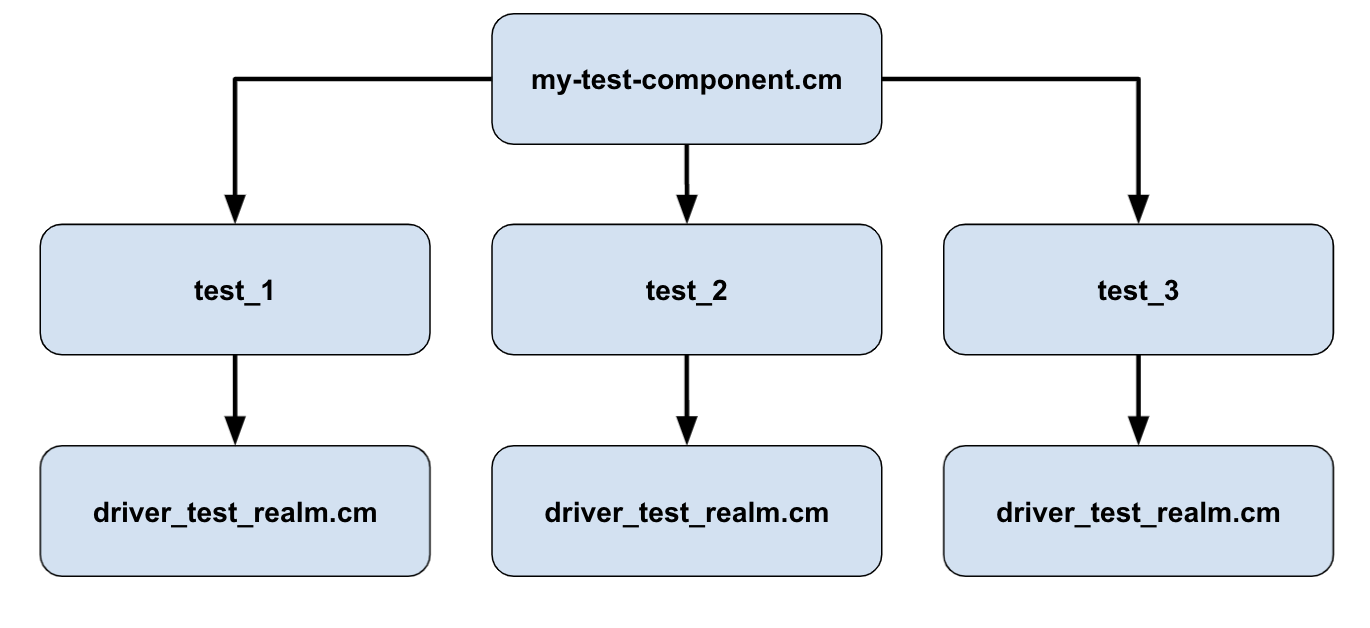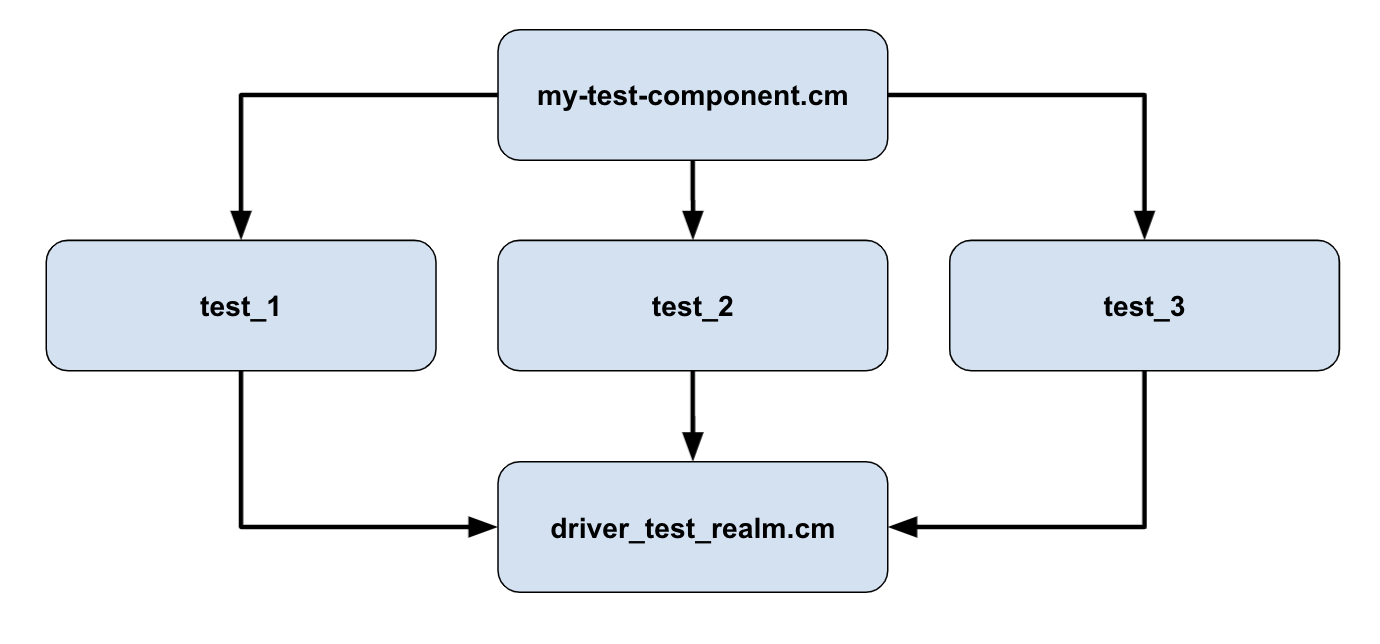驅動程式庫整合測試架構
DriverTestRealm 是整合測試架構,可在密封環境中執行驅動程式。這對驅動程式庫程式作者測試驅動程式,以及系統開發人員執行使用特定驅動程式庫堆疊的整合測試都很有幫助。DriverTestRealm 提供所有 Driver Framework API 的密封版本,並提供與執行中系統幾乎相同的環境。
DriverTestRealm 用於整合測試。如果您想使用輕量單元測試架構,請改用單元測試程式庫。
DriverTestRealm 總覽
DriverTestRealm 是測試可存取的元件。這個元件包含 DriverFramework 的所有元件,例如 DriverManager 和 DriverIndex。模擬這些元件所需的所有功能。

DriverTestRealm 會公開用於啟動 DriverTestRealm 的 fuchsia.driver.test/Realm 通訊協定。Start 函式會接受引數,可用於設定要載入哪些驅動程式、根目錄驅動程式庫,以及 DriverManager 的關閉方式。每個元件只能呼叫 Start 一次;如果每項測試都需要新的 DriverTestRealm,則必須使用 RealmBuilder。
與駕駛人互動
請參閱「使用 DriverTestRealm 搭配服務」。
包含驅動程式
根據預設,DriverTestRealm 元件會從自己的套件載入驅動程式。測試作者必須確保在測試套件中加入所有預期要載入的驅動程式。
繫結驅動程式
根據預設,DriverTest 領域的根驅動程式庫是 test-parent driver。也就是說,如要繫結驅動程式庫,您應建立模擬驅動程式庫,並繫結至測試父項。您可以使用下列繫結規則完成這項作業:
fuchsia.BIND_PROTOCOL == fuchsia.test.BIND_PROTOCOL.PARENT;
模擬驅動程式庫接著可新增具有正確屬性的裝置,讓測試中的驅動程式庫繫結至模擬驅動程式庫。
密封與非密封
使用 DriverTestRealm 有兩種方式。可密封或非密封使用。
密封
在 Driver Test Realm 的密封版本中,每個測試都會取得 Driver Test Realm 元件的專屬版本。也就是說,每項測試都與其他測試隔離。由於每個 DriverTestRealm 都是測試專屬,因此測試不會共用任何狀態。

使用密封的 Driver Test Realm 可能會比較慢,因為每項測試都必須產生及設定新的元件。
非密封
使用 Driver Test Realm 的非密封方式,是指在每個測試例項之間共用單一 Driver Test Realm 子項元件。

測試作者必須特別小心,確保每項測試之間的驅動程式狀態已清除,以免個別測試彼此互動。
使用非密封的 Driver Test Realm 可能會更快,因為每項測試都不需要產生及設定新的元件。測試程式碼也可能會變得更簡單。
DriverTestRealm 範例
以下是使用 DriverTestRealm 的封閉式和非封閉式範例,適用於 C++ 和 Rust。
您可以在 //examples/drivers/driver_test_realm/ 中查看範例。
密封
測試作者可以使用 RealmBuilder,為每項測試建立新的 DriverTestRealm。DriverFramework 提供了一個實用的程式庫,使用 RealmBuilder 中的 DriverTestRealm。
以下是使用 DriverTestRealm 與 RealmBuilder 的範例 BUILD.gn 檔案。請注意,這裡有一個特定的 DriverTestRealm GN 目標可依附,因此測試產生的 CML 就會擁有正確的 RealmBuilder 權限。
C++
test("driver_test_realm_example_hermetic_cpp") {
sources = [ "test.cc" ]
deps = [
"//examples/drivers/driver_test_realm/sample_driver:fuchsia.hardware.sample_cpp",
"//sdk/fidl/fuchsia.driver.test:fuchsia.driver.test_cpp",
"//sdk/lib/async-loop",
"//sdk/lib/async-loop:async-loop-cpp",
"//sdk/lib/component/outgoing/cpp",
"//sdk/lib/device-watcher/cpp",
"//sdk/lib/driver_test_realm/realm_builder/cpp",
"//src/lib/fxl/test:gtest_main",
"//src/lib/testing/loop_fixture",
"//zircon/system/ulib/fbl",
]
}
fuchsia_unittest_package("package") {
package_name = "driver_test_realm_example_hermetic_cpp"
deps = [
# Include your test component.
":driver_test_realm_example_hermetic_cpp",
# Include the driver(s) you will be testing.
"//examples/drivers/driver_test_realm/sample_driver",
# Include the test parent (if your driver binds to it).
"//src/devices/misc/drivers/test-parent",
]
}
荒漠油廠
rustc_test("driver_test_realm_example_realm_builder_rust") {
edition = "2024"
testonly = true
source_root = "test.rs"
sources = [ "test.rs" ]
deps = [
"//examples/drivers/driver_test_realm/sample_driver:fuchsia.hardware.sample_rust",
"//sdk/fidl/fuchsia.driver.test:fuchsia.driver.test_rust",
"//sdk/lib/device-watcher/rust",
"//sdk/lib/driver_test_realm/realm_builder/rust",
"//src/lib/fuchsia-async",
"//src/lib/fuchsia-component-test",
"//third_party/rust_crates:anyhow",
]
}
fuchsia_unittest_package("package") {
package_name = "driver_test_realm_example_realm_builder_rust"
deps = [
# Include your test component.
":driver_test_realm_example_realm_builder_rust",
# Include the driver(s) you will be testing.
"//examples/drivers/driver_test_realm/sample_driver",
# Include the platform bus (if your driver binds to it).
"//src/devices/bus/drivers/platform:platform-bus",
# Include the test parent (if your driver binds to it).
"//src/devices/misc/drivers/test-parent",
]
# There's expected error logs that happen due to races in driver enumeration.
test_specs = {
log_settings = {
max_severity = "ERROR"
}
}
}
以下是每個測試都會產生新 DriverTestRealm 的測試程式碼。
C++
class DriverTestRealmTest : public gtest::TestLoopFixture {};
TEST_F(DriverTestRealmTest, DriversExist) {
async::Loop loop(&kAsyncLoopConfigNeverAttachToThread);
loop.StartThread("bg");
// Create and build the realm.
auto realm_builder = component_testing::RealmBuilder::Create();
driver_test_realm::Setup(realm_builder, loop.dispatcher(), driver_test_realm::Options{},
fuchsia_driver_test::RealmArgs{});
auto realm = realm_builder.Build(loop.dispatcher());
auto boot_result = driver_test_realm::WaitForBootup(realm);
ASSERT_EQ(ZX_OK, boot_result.status_value());
fbl::unique_fd fd;
auto exposed = realm.component().CloneExposedDir();
ASSERT_EQ(ZX_OK, fdio_fd_create(exposed.TakeChannel().release(), fd.reset_and_get_address()));
// Wait for driver.
auto node = driver_test_realm::WaitForNode(realm, "dev.sys.test.sample_driver");
ASSERT_TRUE(node.is_ok());
// TODO(https://fxbug.dev/377735979): Connect using a different mechanism.
zx::result channel =
device_watcher::RecursiveWaitForFile(fd.get(), "dev-topological/sys/test/sample_driver");
ASSERT_EQ(channel.status_value(), ZX_OK);
fidl::ClientEnd<fuchsia_hardware_sample::Echo> client(std::move(*channel));
// Send a FIDL request.
constexpr std::string_view sent_string = "hello";
fidl::WireResult result =
fidl::WireCall(client)->EchoString(fidl::StringView::FromExternal(sent_string));
ASSERT_EQ(ZX_OK, result.status());
ASSERT_EQ(sent_string, result.value().response.get());
}
荒漠油廠
#[fasync::run_singlethreaded(test)]
async fn test_sample_driver() -> Result<()> {
// Create the RealmBuilder.
let builder = RealmBuilder::new().await?;
builder.driver_test_realm_setup().await?;
// Build the Realm.
let instance = builder.build().await?;
// Start DriverTestRealm
instance.driver_test_realm_start(fdt::RealmArgs::default()).await?;
// Connect to our driver.
let dev = instance.driver_test_realm_connect_to_dev()?;
let driver =
device_watcher::recursive_wait_and_open::<fidl_fuchsia_hardware_sample::EchoMarker>(
&dev,
"sys/test/sample_driver",
)
.await?;
// Call a FIDL method on the driver.
let response = driver.echo_string("Hello world!").await.unwrap();
// Verify the response.
assert_eq!(response, "Hello world!");
Ok(())
}
#[fasync::run_singlethreaded(test)]
async fn test_platform_bus() -> Result<()> {
// Create the RealmBuilder.
let builder = RealmBuilder::new().await?;
builder.driver_test_realm_setup().await?;
// Build the Realm.
let instance = builder.build().await?;
// Start DriverTestRealm.
let args = fdt::RealmArgs {
root_driver: Some("fuchsia-boot:///platform-bus#meta/platform-bus.cm".to_string()),
..Default::default()
};
instance.driver_test_realm_start(args).await?;
// Connect to our driver.
let dev = instance.driver_test_realm_connect_to_dev()?;
device_watcher::recursive_wait(&dev, "sys/platform").await?;
Ok(())
}
非密封
以下是測試的基本範例,這個測試會啟動 DriverTestRealm 元件,然後連線至 /dev,查看已載入的驅動程式庫。
首先,請務必正確設定建構規則。測試套件必須包含 DriverTestRealm 元件,以及所有要載入的驅動程式。將驅動程式新增至套件後,DriverTestRealm 就會自動顯示這些驅動程式。
C++
test("driver_test_realm_example_non_hermetic_cpp") {
sources = [ "test.cc" ]
deps = [
"//sdk/fidl/fuchsia.driver.test:fuchsia.driver.test_cpp",
"//sdk/lib/component/incoming/cpp",
"//sdk/lib/device-watcher/cpp",
"//sdk/lib/driver_test_realm:static",
"//sdk/lib/syslog/cpp",
"//third_party/googletest:gtest",
]
}
fuchsia_unittest_package("package") {
package_name = "driver_test_realm_example_non_hermetic_cpp"
deps = [
":driver_test_realm_example_non_hermetic_cpp",
# Add drivers to the package here.
# The test-parent driver is the default root driver for DriverTestRealm.
"//src/devices/misc/drivers/test-parent",
]
}
以下是測試設定的樣貌。請注意,您必須先呼叫 fuchsia.driver.test/Realm:Start,才能執行測試架構。Start 的引數可設定為設定 DriverManager 實作項目。
C++
TEST(DdkFirmwaretest, DriverWasLoaded) {
zx::result channel = device_watcher::RecursiveWaitForFile("/dev/sys/test");
ASSERT_EQ(channel.status_value(), ZX_OK);
}
int main(int argc, char **argv) {
fuchsia_logging::LogSettingsBuilder builder;
builder.WithTags({"driver_test_realm_test"}).BuildAndInitialize();
// Connect to DriverTestRealm.
auto client_end = component::Connect<fuchsia_driver_test::Realm>();
if (!client_end.is_ok()) {
FX_LOG_KV(ERROR, "Failed to connect to Realm FIDL", FX_KV("error", client_end.error_value()));
return 1;
}
fidl::WireSyncClient client{std::move(*client_end)};
// Start the DriverTestRealm with correct arguments.
auto wire_result = client->Start(fuchsia_driver_test::wire::RealmArgs());
if (wire_result.status() != ZX_OK) {
FX_LOG_KV(ERROR, "Failed to call to Realm:Start", FX_KV("status", wire_result.status()));
return 1;
}
if (wire_result.value().is_error()) {
FX_LOG_KV(ERROR, "Realm:Start failed", FX_KV("status", wire_result.value().error_value()));
return 1;
}
// Run the tests.
::testing::InitGoogleTest(&argc, argv);
return RUN_ALL_TESTS();
}
請注意,DriverTestRealm 啟動後,測試環境會在其元件命名空間中提供所有 DriverFramework API。您可以監控並開啟 /dev/ 目錄,以連線至驅動程式。
簡單範例
Simple 程式庫可讓測試使用 DriverTestRealm 和預設引數。
大多數整合測試都適用於 DriverTestRealm 的預設設定,因此不需要將引數傳遞至 Start。如果是這種情況,SimpleDriverTestRealm 就會自動啟動。
C++
test("driver_test_realm_example_simple_cpp") {
sources = [ "test.cc" ]
deps = [
"//sdk/lib/device-watcher/cpp",
"//sdk/lib/driver_test_realm/simple",
"//src/lib/fxl/test:gtest_main",
]
}
fuchsia_unittest_package("package") {
package_name = "driver_test_realm_example_simple_cpp"
deps = [ ":driver_test_realm_example_simple_cpp" ]
}
荒漠油廠
rustc_test("driver_test_realm_example_simple_rust") {
edition = "2024"
source_root = "test.rs"
sources = [ "test.rs" ]
deps = [
"//sdk/lib/device-watcher/rust",
"//sdk/lib/driver_test_realm/simple",
"//src/lib/fuchsia-async",
"//src/lib/fuchsia-fs",
"//third_party/rust_crates:anyhow",
]
}
fuchsia_unittest_package("package") {
package_name = "driver_test_realm_example_simple_rust"
deps = [ ":driver_test_realm_example_simple_rust" ]
}
這項測試看起來與前述測試相同,但不需要設定 main 函式來呼叫 fuchsia.driver.test/Realm:Start。
C++
TEST(SimpleDriverTestRealmTest, DriversExist) {
zx::result channel = device_watcher::RecursiveWaitForFile("/dev/sys/test");
ASSERT_EQ(channel.status_value(), ZX_OK);
}
荒漠油廠
#[fasync::run_singlethreaded(test)]
async fn test_driver() -> Result<()> {
let dev = fuchsia_fs::directory::open_in_namespace("/dev", fuchsia_fs::Flags::empty())?;
device_watcher::recursive_wait(&dev, "sys/test").await?;
Ok(())
}
常見問題:
- 驅動程式未繫結
- 確認套件中包含驅動程式庫
- 如果使用預設的根目錄驅動程式庫,請務必加入
src/devices/misc/drivers/test-parent。
- 對 /dev/ 的呼叫會掛斷
- 請確認已呼叫
fuchsia.driver.test/Realm:Start。
- 請確認已呼叫
fuchsia.driver.test/Realm:Start會傳回 ZX_ERR_ALREADY_BOUND- 每個元件只能呼叫 Start 一次。如果您想為每項測試建立新的 DriverTestRealm,請參閱 RealmBuilder 部分。

